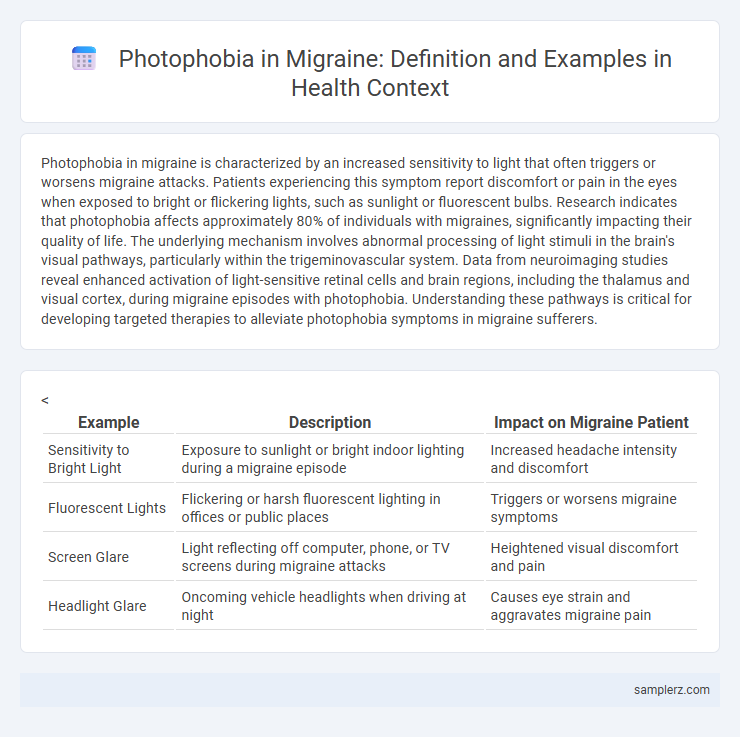Photophobia in migraine is characterized by an increased sensitivity to light that often triggers or worsens migraine attacks. Patients experiencing this symptom report discomfort or pain in the eyes when exposed to bright or flickering lights, such as sunlight or fluorescent bulbs. Research indicates that photophobia affects approximately 80% of individuals with migraines, significantly impacting their quality of life. The underlying mechanism involves abnormal processing of light stimuli in the brain's visual pathways, particularly within the trigeminovascular system. Data from neuroimaging studies reveal enhanced activation of light-sensitive retinal cells and brain regions, including the thalamus and visual cortex, during migraine episodes with photophobia. Understanding these pathways is critical for developing targeted therapies to alleviate photophobia symptoms in migraine sufferers.
Table of Comparison
| Example | Description | Impact on Migraine Patient |
|---|---|---|
| Sensitivity to Bright Light | Exposure to sunlight or bright indoor lighting during a migraine episode | Increased headache intensity and discomfort |
| Fluorescent Lights | Flickering or harsh fluorescent lighting in offices or public places | Triggers or worsens migraine symptoms |
| Screen Glare | Light reflecting off computer, phone, or TV screens during migraine attacks | Heightened visual discomfort and pain |
| Headlight Glare | Oncoming vehicle headlights when driving at night | Causes eye strain and aggravates migraine pain |
Understanding Photophobia in Migraine Attacks
Photophobia during migraine attacks manifests as an intense sensitivity to light that can exacerbate headache pain and trigger nausea or dizziness. This symptom is linked to abnormal activation of the trigeminovascular system and heightened responsiveness in the visual cortex. Understanding the neural mechanisms behind photophobia helps in developing targeted treatments, such as light-modulating lenses and medications that reduce cortical excitability.
Common Light Triggers for Migraine-Induced Photophobia
Migraine-induced photophobia often involves heightened sensitivity to specific light wavelengths, with common triggers including fluorescent lighting, computer screens, and sunlight. Blue light emitted from digital devices exacerbates symptoms by activating hyperexcitable neurons in the visual cortex. Managing exposure to these specific light sources is crucial for reducing migraine intensity and frequency.
Day-to-Day Examples of Photophobia During Migraines
Photophobia during migraines often manifests as intense light sensitivity, making exposure to daylight or fluorescent lighting unbearable. Everyday situations such as working on a computer, driving in bright sunlight, or being in a well-lit office can trigger or worsen migraine symptoms. Wearing sunglasses indoors or using screen dimming apps are common coping strategies to manage this disabling sensitivity.
Indoor Lighting and Migraine Photophobia Episodes
Indoor lighting, especially fluorescent and LED lights, can trigger or worsen migraine photophobia episodes by emitting flickering or harsh light that overstimulates the visual cortex. Migraine sufferers often experience heightened sensitivity to these artificial light sources, leading to increased headache intensity and prolonged recovery times. Adjusting indoor lighting to softer, warmer tones and using light-filtering glasses may significantly reduce photophobia symptoms during migraine attacks.
How Digital Screens Worsen Photophobia in Migraine Sufferers
Exposure to digital screens emits blue light that aggravates photophobia symptoms in migraine sufferers by overstimulating retinal cells and disrupting neural pathways associated with light sensitivity. Prolonged screen time increases visual strain, triggering or intensifying migraine attacks characterized by heightened light aversion and discomfort. Implementing screen filters or reducing screen brightness can help mitigate digital screen-related photophobia and reduce migraine severity.
Photophobia Challenges with Outdoor Sunlight Exposure
Photophobia during migraine attacks intensifies discomfort significantly when exposed to outdoor sunlight, as bright light triggers heightened sensitivity in the optic nerves. This extreme light sensitivity often leads to increased headache severity, nausea, and visual disturbances, compounding the migraine symptoms. Managing photophobia requires strategic use of sunglasses with polarized lenses and seeking shaded environments to mitigate the impact of sunlight exposure.
Work and School: Navigating Photophobia in Migraine
Photophobia during migraines often disrupts productivity in work and school environments, as exposure to bright lights or computer screens intensifies discomfort. Implementing strategies such as using screen filters, dimming lights, or taking frequent breaks helps manage sensitivity and maintain focus. Awareness and accommodations by employers and educators, including flexible deadlines and quiet spaces, significantly improve the ability to cope with migraine-triggered photophobia.
Driving and Photophobia: Migraine Safety Considerations
Photophobia, a common symptom of migraine, significantly impairs driving by causing increased light sensitivity and visual discomfort, which can lead to dangerous distractions and delayed reaction times. Migraines with photophobia often result in difficulty focusing on the road, especially during bright sunlight or nighttime glare from headlights, necessitating preventive measures such as tinted lenses or avoiding driving during severe episodes. Understanding the impact of photophobia on driving safety is critical for migraine sufferers to reduce accident risk and enhance overall roadway safety.
Coping Strategies for Migraine-Related Photophobia
Migraine-related photophobia often manifests as extreme sensitivity to light, triggering intense discomfort and headaches. Effective coping strategies include wearing polarized sunglasses, using dim lighting, and implementing gradual light exposure therapy to minimize symptoms. Incorporating relaxation techniques such as mindfulness and regular sleep patterns can further reduce the frequency and severity of photophobia during migraines.
Real-Life Patient Experiences of Photophobia in Migraine
Real-life patient experiences of photophobia in migraine often describe intense sensitivity to light that exacerbates headache pain, forcing sufferers to seek dark, quiet environments. Many report that everyday lighting, such as fluorescent bulbs or sunlight, triggers or worsens their symptoms, leading to missed work or social activities. These vivid accounts highlight the profound impact of photophobia on quality of life and emphasize the need for personalized migraine management strategies.

example of photophobia in migraine Infographic
 samplerz.com
samplerz.com